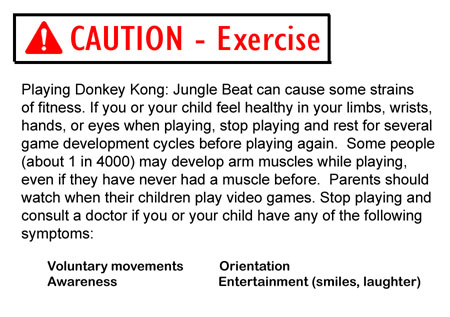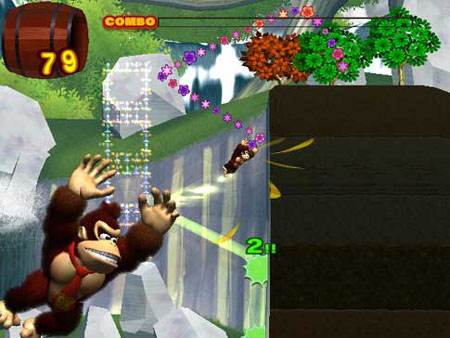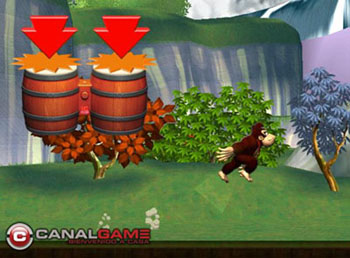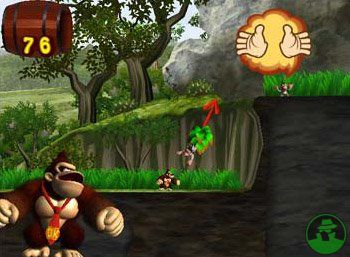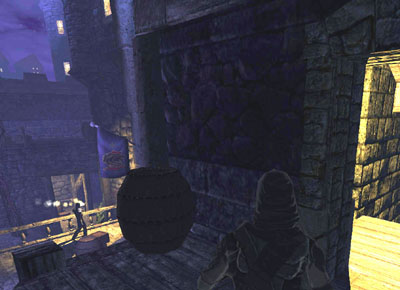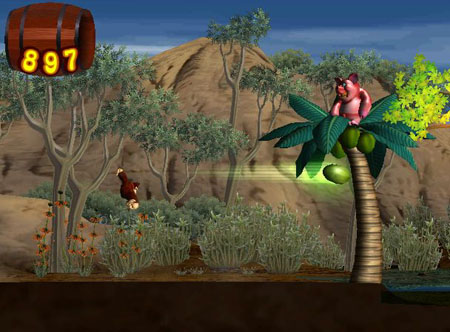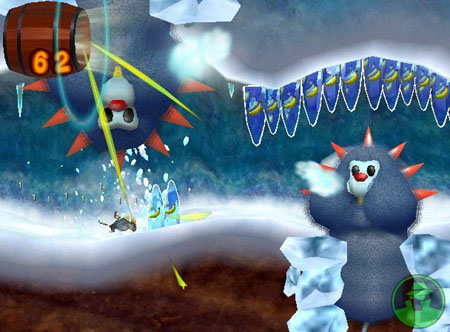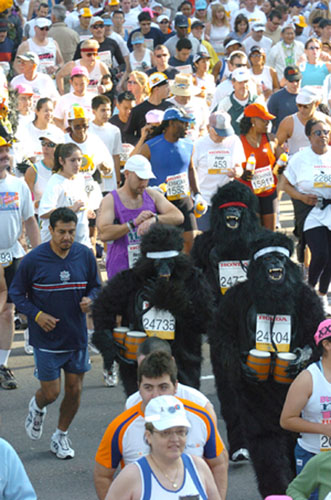
 |
|||
|
Developer and
Publisher: Nintendo
Jungle Beat definitely made me sore under the armpits, though. Maybe this game should have a warning:
You Hit The Plastic Bongo Drums In Jungle Beat,
you use the DK Bongos controller to run Donkey Kong through adventure
landscapes that vary between fast-faced, ever-forward obstacle courses
and more traditional Super Mario Bro.s –esque platforming.
One bongo moves DK right, one moves him left, and both simultaneously
make him jump. Hit the bongos faster for faster movement. The microphone
on the controller detects claps, which is mapped onto a highly contextual
‘action’ command which can collect resources, trigger
environmental tools, attack enemies, deflect attacks, and so on.
‘Action’ is a bit of a silver bullet, and I can’t
imagine playing this game if I actually had to clap every time I
needed to use it. Damien
taught me the rim shot trick of slapping the side of a bongo, which
the mic interprets as a clap, and I now pass the savings on to you. So you flail away
on these cheap plastic drums while staring intently at the TV and
swaying involuntarily. Somehow, you are still an adult when you
do this. Donkey Kong likes to beat the tar out of friendly and harmless-looking
native species of the cartoon worlds he inhabits, so I guess that
makes it 'edgy' or a 'dark comedy'.
The design does
a sensational job drawing players through the barrier to entry posed
by the unconventional controller. I mean, you're sitting on the
floor with some drums while a big ape in the jungle is in on TV;
it's not perfectly clear what you should do. Thus in the game's
intro, you are dropped into sparse, forgiving environments where
intuitive animating icons, accompanied by gesturing 3D monkeys,
guide you through the basics of playing the game, both in terms
of the use of the controller and the game's conventions. This is
very fast and effective, and you're working your way through the
first level before you realize it. The finer points of gameplay
are communicated between levels via stylized video clips. I generally
consider games to be utter failures if you have to reference the
manual, and Jungle Beat definitely did its part to make manuals
obsolete.
I'd say the most
amazing accomplishment of the design is how it maximizes the limited
expression provided by the controls. This is done in part via easily-recognizable
and intuitive environmental tools, such as flower/catapults that
you climb and activate to hurl yourself, vertical tubes that you
ascend by hopping from one wall to the other, waiting monkey allies
that grab and fling you, vines on which you can swing back and forth
to build momentum, not to mention the usual cast of platforms, elevators,
and transporters that look like robot snakes. These same controls
also enable you to collect, carry, block, deflect, punch, swim,
etc., etc., and despite all of the overloading, there is never a
moment when DK takes an action when you had intended another. This
degree of precise expressiveness coming out of a controller with
essentially 3 buttons (read: fewer input channels than an Atari
joystick) truly illustrates how most of us are walking fiascos who
should be fired immediately for filling the Xbox controller up to
the last analog interpretation while our character still can't reliably
climb walls. Trapeze Artists and Monkey-Shaped Pinballs Jungle Beat's
world is rich and the pacing is fast, so much of the gameplay involves
looking ahead and planning, especially in the pinball-style obstacle
courses. At its best moments, Jungle Beat weaves the abundance of
player actions into a glorious, trapeze-style tapestry in which
DK bounds from vine to wall to trampoline to floating bubble to
the waiting arms of his monkey friends while fruits and nuts bounce
around and get pummeled into the faces of frustrated cartoon foes,
all of which is expressed in the RW by your frantic bongo hits,
rim shots, and involuntary swaying. Never before has Donkey Kong
felt so elegant and dexterous. I have to assume this was the holy
grail of their design, and they accomplished it.
It makes for a
really great party game, too! Or rather I think it should. If everyone
loves to play Karaoke
Revolution and DDR at parties,
why aren't they as enthusiastic about playing Jungle Beat? You break
out the Karaoke mic, and suddenly everyone in the room gets peer
pressured into singing Avril Lavigne, but people just kind of stare
at you suspiciously when you offer the plastic drums, no matter
how drunk they are. They will try it once warily, then stop with
a satisfied but distasteful air. I used to assume that the unconventional
interfaces were what leveled the playing field with respect to drawing
in non-gamers. Now I suspect that the real difference is that Jungle
Beat still presents as a video game, whereas the Revolution games
feel more like interactive toys.
Variety certainly
seems to be the new style in games these days, and Jungle Beat often
incorporates theirs directly into the standard game world as opposed
to, say, farming it out to standalone mini-games. There is an assortment
of animal-flavored vehicles, focused mini-challenges within levels,
varying terrain types, and the ubiquitous boss monsters. The boss
monster challenges are well-designed, and unlike in the Zelda games
they are not so transparently the mid-term exam for accumulated
player skills. However, they do become highly demanding towards
the end, stripping over half the points accumulated in the previous
levels, which implies that they are intended to be played repeatedly.
All games satisfy certain fundamental psychological urges. For example, Tetris is for you people who love to convert chaos into order (the message is that you fools will ultimately fail, btw). Diablo is for Cleaners: those who like to take messy dungeons and tidy up all the monsters and treasures and clutter, leaving spare and sterile corridors in their wake. Often, games allow us to satisfy these urges completely as a substitute for the fact that we can't do so in real life, as the games provide artificial, controlled environments and player superpowers. Personally, I'm a bit of a Cleaner, and I sometimes found that Jungle Beat frustrated my completist urge: scoring in the game is essentially a function of how much you leave behind in your mad dash through the level, and I never played perfectly enough to feel satisfied that the level was adequately cleaned. I'd lie awake at night. How Bongo Can You Get? If someone told me to design an innovative video game with bongos, I'd start by thinking about the aesthetic relationship between the controller and the gameplay. With Jungle Beat, you can easily substitute a standard controller, at which point the question is: what do the bongos contribute to the game experience? They certainly make it more physically active, but it's worth noting that apart from the framing fiction little about Jungle Beat is particularly "bongo-esque", which is kind of an unfortunate miss. Call me a fucking snob with jacked up expectations, as you'd be correct and I wouldn't be too offended, but still I think that's kind of important. Perhaps DK's actions
could be more effective if you play the drums along with the beat
of the background music, to encourage the player to pay attention
to rhythm? Maybe levels could be designed in a way that naturally
leads to rhythmic drumming? Or maybe there could be mini-games or
separate sections that are more about playing drums than controlling
DK per se? There is a tension here between the nature of the peripheral-based
gameplay and the intended audience. Specifically, since the game
is intended for kids it might be too much to ask them to be rhythmically
accurate on top of the other demands of the game. No one wants to
come home from a brutal day at kindergarten only to have their relaxing
diversion frustrate them when it was supposed to help them unwind.
Still, a rhythm/action hybrid game is an interesting concept that
if designed correctly could produce some great innovation. I've
heard that Rez
tried to pull that off, but Brian
says they neglected to put in the "fun" that the kids
talk so much about.
|
|||
| back to the Reviews list |



